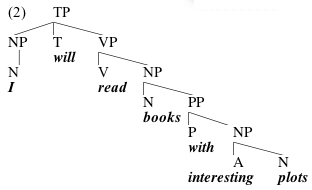
(1)
TP→NP T VP
VP→V (NP) (PP)
NP→ (Det) (A) N (PP)
PP→P (NP)
Put these together with a lexicon (which lists words that count as instances of N, A, P, and so on), and you can generate trees like:

The little mini-grammar in (1) has a couple of desirable properties already: it's recursive, and it can handle certain cases of ambiguity.
And yet, the mini-grammar in (1) is not the final word in grammar. It has at least three serious problems:
VP→V (NP) (PP)
We said before that we're going to combine these rules with lexical entries to get fragments of English. Lots of lexical choices won't work out, of course:
(3) a. The dragon devoured the villagers. b. *The dragon devoured. (4) a. The dragon rejoiced. b. *The dragon rejoiced his victory. (5) a. The dragon put the peasant upon the plate. b. *The dragon put. c. *The dragon put the peasant. d. *The dragon put upon the plate.
The data in (3-4) are described by a classic observation: some verbs are transitive (they require objects) and others are intransitive (they can't have objects). And, in fact, as we see in (5), there are verbs with even more extensive requirements; put is not only transitive, but needs to be followed by a PP, as well.
So in the lexical entry for put we'll need to have the information "needs an NP and a PP". And in fact, all of our lexical entries for verbs will have information in them like this. Given that we already have to state all of this information in the lexicon, is there any point in stating it again in phrase structure rules?
Many of us have decided that there isn't. The fact that we need to state facts about the requirements of particular heads, we think, will allow us to bleach a lot of the information out of the phrase structure rules, making them vaguer and simpler. We'll refer to this type of requirement imposed by particular heads as selection.
Now, it seems that not everything is selected:
(6) a. The dragon devoured the villagers (yesterday) (in Omaha) b. The dragon rejoiced (yesterday) (in Omaha) c. The dragon put the peasant upon the plate (yesterday) (in Omaha)It looks like there are some kinds of phrases (like the villagers, the peasant, and upon the plate in the examples above), which are picky about which heads they cooccur with; you can get the villagers after devoured, for example, but not after rejoiced. We'll say that heads get to select (or subcategorize) for certain types of phrases, and we'll refer to phrases that are selected for as complements of the heads that are selecting for them. So, for example, devoured is selecting for the villagers in (6a).
On the other hand, there are also phrases like yesterday or in Omaha, which don't seem to care what type of verb they combine with; you can do anything in Omaha, more or less. These phrases apparently aren't selected at all; we'll refer to them as adjuncts.
We'll do some more discussion of the nature of selection later on, but for now, let's turn to one of the other problems that was listed above; these phrase structure rules give us an insufficiently fine-grained structure to account for all the structural facts we want to handle.
Consider, for starters, an example like (7):
(7) John decided on the boat.(7) is ambiguous; it can have either of the meanings in (8):
(8) a. John made his decision while he was on the boat. b. John chose the boat.
Now, the reading in (8a) seems like an instance in which on the boat is being treated like an adjunct; it's like in Omaha in the examples in (6) above. Basically, just as you can do almost anything in Omaha, you can do almost anything on a boat, and deciding is one of the things you can do there. In other words, there's no selection relation between decide and on the boat, when the sentence is interpreted as in (8a).
On the other hand, the reading in (8b) is a little different. Here it's as though the string decide on has been given the meaning chose. That's not something you can do with any random verb; it just isn't the case that whenever you combine on the boat with a verb, the verb and on can be treated as a complex verb, taking the object of on as its object. In other words, most of the time, if you add on the boat to a VP, you only get a reading parallel to (8a), in which whatever the VP describes happened on the boat; there's nothing parallel to (8b):
(9) a. The dragon rejoiced on the boat (="The dragon rejoiced while he was on the boat") b. The captain danced a hornpipe on the boat (="The captain danced a hornpipe while he was on the boat") ...etc.So the availability of reading (8b) appears to be a special property of decide. That is, decide appears to be selecting on the boat, in this reading.
If these intuitions about the readings in (8) are correct, then apparently on the boat in (7) can be either a complement or an adjunct of decide. Now, it turns out that the readings in (8) can be affected by various kinds of things we can do to the verb phrase; it's not the case that both of these readings are always available. For example, it's in general possible to replace all or part of a VP with expressions like do so, do it, etc:
(10) John painted his house orange, and Mary did so/did it too.When we apply this process (sometimes called VP-pronominalization) to (7), we can get:
(11) John decided on the boat, and Mary did so on the plane.Interestingly, however, (11) has only the reading parallel to (8a); that is, (11) only means that John and Mary made their decisions on the boat and the plane, respectively. It can't mean that John chose the boat, and Mary chose the plane.
There also seems to be a rule about the relative ordering of complements and adjuncts. Consider what happens when we insert in Omaha, a clear adjunct, in examples like (7):
(12) a. John decided on the boat in Omaha. b. John decided in Omaha on the boat.(12a) has both of the readings in (8), but (12b) has only the reading in (8a); (12b), unlike (12a), can't mean that John chose the boat while he was in Omaha. We can describe the relevant facts about (12) with the following generalization:
Complement/Adjunct Ordering
If a verb has both a complement and an adjunct, the complement must be closer to the verb than the adjunct.
(Another way of stating the generalization would require complements to precede adjuncts. This would work just as well for the data in (12), but we'll see that the generalization is correct as stated).
We can capture the ordering generalization above by requiring VPs containing both a complement and an adjunct to conform to something like the tree in (13a), rather than the one in (13b):

The trees in (13) both involve a new type of node, the V' (pronounced "v-bar"). V' is clearly a projection of V (since it comes between V and VP), but it is neither a head nor a maximal projection, so we're giving it a new kind of label.
Our examples of distinctions between complements and adjuncts, so far, have all involved VPs. The same distinction can be demonstrated for NPs. Consider the NP in (14):
(14) a student of physics from BrazilThe noun student in (14) is followed by two PPs, of physics and from Brazil. Falling back on our first test for the complement/adjunct distinction, we can note that, when we consider the nouns that these two PPs can combine with, of physics is much 'pickier' than from Brazil. Almost anything can be from Brazil, but of physics combines with a restricted set of nouns:
(15) a. the student/professor/textbook/*mailman/*orange/*footstool of physics b. the student/professor/textbook/mailman/orange/footstool from BrazilSo we're entitled to suspect, just on the results of this 'pickiness' diagnostic, that of physics is a complement of student, while from Brazil is an adjunct. And our other tests seem to bear this out; for example, just as we observed earlier for VPs, the complement must be closer to the head than the adjunct:
(16) a. the student [of physics] [from Brazil] b. *the student [from Brazil] [of physics]These NPs have paraphrases in which the complement and the adjunct precede the N:
(17) a. the [Brazilian] [physics] student b. *the [physics] [Brazilian] studentThe data in (17) allow us to confirm that we were right to state the condition on the relative ordering of the complement and the adjunct in terms of closeness to the head; the generalization is that the complement must be closer to the head than the adjunct (and not, for example, that the complement must precede the adjunct; that would be true in (16) but not in (17)).
It is sometimes claimed that NPs have a diagnostic parallel to VP-pronominalization, which distinguishes between NP-internal complements and adjuncts; it's called one-replacement. As you can see in (18-19), one-replacement works better as a diagnostic for prenominal complements and adjuncts (as in (18)) than it does for postnominal complements and adjuncts (as in (19), where the contrast is much less strong):
(18) a. ...a Rwandan student, and a Brazilian one b. *...a chemistry student, and a physics one (19) a. ...a student from Rwanda, and one from Brazil b. ?...a student of chemistry, and one of physicsLike VP-pronominalization, one-replacement is supposed to replace part of the NP, sparing adjuncts but obligatorily wiping out complements.
Complements and adjuncts also differ in how they interact with certain modifiers, in a way that our theory ought to be able to capture. Consider, for example, the adjective alleged:
(20) a. an alleged Brazilian student b. a Brazilian alleged studentGiven that alleged can combine with any noun, we're inclined to regard it as an adjunct. And the word order freedom in (20) seems to bear that out; alleged can go on either side of known adjuncts like Brazilian. There's an interesting consequence for interpretation, though. In (20a), what's alleged about this person is that they are a Brazilian student; if the allegations are wrong, it's possible that they're actually a Venezuelan professor, for example. In (20b), on the other hand, I'm asserting that the person is Brazilian, and just reporting allegations that they're a student; if the allegations are wrong, then the person might be a Brazilian professor, but if I'm right, they're definitely from Brazil, whatever else they turn out to be.
Now, we could have a couple of theories about why the meanings in (20) differ as they do. It might be that alleged is taken to modify everything that follows it, for example. Or we might describe these facts by saying that alleged modifies its sister. To see that, consider these trees for the NPs in (20), in which the sister of alleged has been circled:
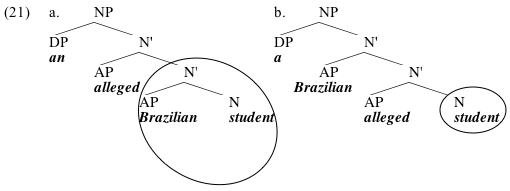
As you can see, in these NPs, the descriptions "words which linearly follow alleged" and "words which make up the sister of alleged" pick out the same words, so either of these descriptions would give us the right result here. To see a difference between these theories, consider the examples in (22):
(22) a. an alleged student from Brazil b. alleged student of physicsThe examples in (22) differ in an interesting way. In (22a), it is alleged that the person in question is a student, but not necessarily that they are from Brazil; their Brazilian origin could be an established fact. In other words, a generalization like "alleged modifies all the words following it in the NP" seems to fail here; alleged doesn't have to modify from Brazil in (22a). In (22b), by contrast, the allegation must be that the person in question is a student of physics; there is no ambiguity comparable to the one in (22a). The theory that we have developed captures this, as long as alleged is taken to modify its sister; because of physics is a complement while from Brazil and alleged are adjuncts, (22a) may have either of the trees in (23), while (22b) must have the tree in (24):
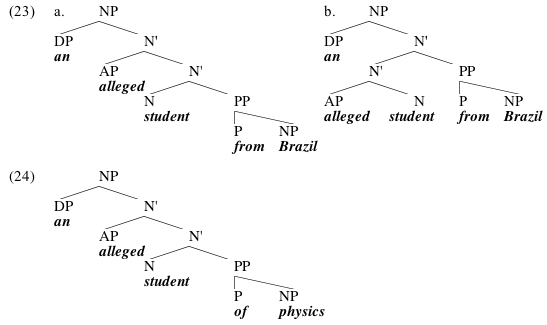
Here our theory seems to get all the facts correctly; alleged modifies its sister, whether this is student from Brazil, as in (23a), student, as in (23b), or student of physics, as in (24). Because of physics is a complement, it must be a sister of the head N, and therefore can only have the tree in (24); it cannot have a tree comparable to the one in (23b). By contrast, from Brazil is an adjunct, and therefore may appear either as a sister of the head (as in (23a)) or not (as in (23b)).
Thus far, then, we have established a distinction between complements (phrases selected by a head) and adjuncts (non-selected phrases), which seems to be represented syntactically; complements must be sisters of the head which selects them, while adjuncts need not be sisters of any head. We have decided that these can be distinguished from each other by, at least, the following tests:
| Optional Reading: This is a chapter of a textbook by Andrew Radford (Transformational grammar: a first course, Cambridge University Press, 1988). Parts of it are out of date-for example, you should ignore his rules for introducing adjuncts, complements, etc., which are superceded by the operation of Merge that we will develop below-but the arguments for the different layers of structure are still useful. |
Before we conclude this section, we should consider a few more possible tests for the complement/adjunct distinction. One is obligatoriness; we have seen that some complements are obligatory:
(25) The dragon devoured *(the peasant)
However, we have also seen examples showing that not all complements are obligatory; student need not be followed by of physics, for example. So obligatoriness isn't a perfectly reliable test. It may be true that all obligatory things are selected by something, but it clearly isn't true that all selected things are obligatory.
We should also be careful about relying on particular choices of preposition as tests for adjunct/complement status. In our examples here, for example of has always headed a complement PP, and you might now be hoping that that's always true. Sadly, it isn't. Consider NPs like:
(26) a student of impeccable character
(26) has two readings; the student may have impeccable character, or be someone who studies impeccable character. The first of these has of impeccable character as an adjunct, while the second has the same PP as a complement. I'll leave the proof of this as an exercise for the reader; you could start by considering the fact that a student from Brazil of impeccable character only means that the student has impeccable character, not that she studies it.
Finally, for NP complements and adjuncts, there's one more test; you can ask questions about NP complements, but not NP adjuncts:
(27) a. What subject is she a student of? b. *What color hair is she a student with?So we've now seen some evidence for a syntactically represented complement/adjunct distinction, and for an intermediate level of projection between the head and the maximal projection, which we've called X'. Here's an algorithm for constructing trees which seems to build the trees we've decided we need:
(i) Merge green and table, projecting the label of table to the new constituent:

(ii) Merge the and green table, projecting the label of green table:
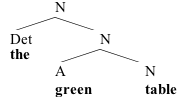
(iii) Finally, Merge under, projecting the label of under:
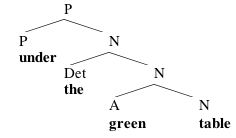
Now, in the above trees, I haven't distinguished between nodes with the same label; there aren't any NPs or N's here. Like most syntacticians, I actually find that Ps and 's make trees easier to process, so I'll add them. But it's worth emphasizing that these aren't supposed to have any real status as part of the syntactic representation; they're just there to make trees easier to read. You can add them using the following convention:
Given a sequence of nodes with the same label X in immediate dominance relations with each other:
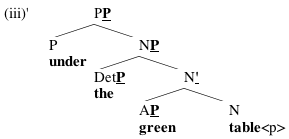
We'll discuss this Merge algorithm further, along with some of its consequences, in the next section. For now, let's see how far we've gotten in being able to account for the phenomena we're using as diagnostics for the complement/adjunct distinction:
| Optional Reading: For an alternative to this way of handling one-replacement, consider this paper by Heidi Harley ("Bare Phrase Structure, acategorial roots, one-replacement, and unaccusativity," 2005, in Harvard working papers on Linguistics v. 9, ed. by Slava Gorbachov and Andrew Nevins). The paper contains a lot of stuff that we haven't gotten to yet; part of her argument is based on the behavior of unaccusatives, for example, which we haven't yet had a chance to talk about. Feel free to ask about anything too baffling! |